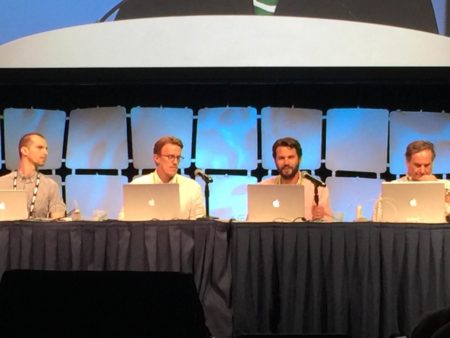Though Pixar was missing from the show floor at SIGGRAPH, the company had several studios showing off their work in Renderman including MPC’s work on The Jungle Book. Pixar did rent a room on the second floor providing sessions about their software which were not officially part of SIGGRAPH open to all attendees including those with Exhibits Pass only.
Universal Scene Description (USD) Goes Open Source
Tuesday Pixar made an announcement. Pixar Animation Studios announced today the official open source release of Universal Scene Description (USD), technology used for the interchange of 3D graphics data through various digital content creation (DCC) tools. USD provides an effective and scalable solution for the complex workflows of CG film and game industry studios.
“We believe that being open with our technology and sharing it with our peers in the industry is how we can best continue to drive innovation,” says Ed Catmull, President, Pixar and Walt Disney Animation Studios. “It’s in that spirit that we’re happy to be opening up USD.”

01 – Pixar opens up its Universal Scene Description technology for a robust and scalable interchange format for the 3D industry.
With this initial release, Pixar is opening up its development process and providing code that can be used for internal development at studios, providing flexibility & control for the studios. “USD synthesizes years of engineering aimed at integrating collaborative production workflows that demand a constantly growing number of software packages,” says Guido Quaroni, Vice President of Software Research and Development at Pixar.
Broad Industry Support
USD provides a rich and powerful toolset for reading, writing, editing, and rapidly previewing 3D scene data. Included in this release is Hydra, a high-performance preview renderer capable of interactively displaying large data sets.USD will give studios powerful toolsets for reading, writing, editing, and rapidly previewing 3D scene data. Creating better collaboration and performance for artists. If you are attending SIGGRAPH 2016, you know real time rendering is a primary focus.
“With USD, Hydra, and OpenSubdiv, we’re sharing core technologies that can be used in filmmaking tools across the industry,” says George ElKoura, Supervising Lead Software Engineer at Pixar. “Our focus in developing these libraries is to provide high-quality, high-performance software that can be used reliably under demanding production scenarios.”
“Integrating Hydra into our proprietary Virtual Production Renderer helped us solve one of our biggest challenges,” says Kevin Wooley, Virtual Production Engineering Lead at ILM. “With the performance improvement, we can handle incredibly complicated digital environments, with thousands of pieces of geometry, while preserving the editability of the scene.”

02 – Notice all those Mac Books! – Photo from Pixar announcement on USD. From left to right: Rob Legato, Production VFX Supervisor; Adam Valdez VFX Supervisor at MPC, London; Andy Jones, Animation Supervisor; and Keith Miller, VFX Supervisor at WETA. Image: Akiko Ashley for Architosh. All rights reserved.
Along with USD and Hydra, the distribution ships with USD plugins for some common DCCs, such as Autodesk’s Maya and The Foundry’s Katana.
We are committed to working with Pixar to make USD the platform-independent scene representation of choice for Maya artists,” says Marc Stevens, Vice President of Film & Television, Autodesk.
“The Foundry strives to constantly deliver the best innovations to our customers and one of the best ways we can do that is through our partners, so we were delighted to work with Pixar on the release of USD,” says Andy Whitmore, Chief Product Officer at The Foundry. “This technology will ultimately give companies better and more powerful pipelines by building more robust connections between their tools of choice, resulting in more empowered artists and therefore greater creativity.”
Before Pixar open sourced their code, it got a lot of feedback from vendors and studios to do advanced testing to see understand the needs of the community.
“In designing and refining USD’s concepts and APIs, we’ve worked closely with our own internal production clients, as well as with other studios, who have already provided feedback that helped shape USD’s evolution,” says Sebastian Grassia, USD Lead Engineer.
Studios such as MPC, Double Negative, ILM, and Animal Logic were among those who provided valuable feedback in preparation for this release.
MPC showed off impressive work in Pixar’s Renderman at SIGGRAPH in the Production Session on Tuesday with VFX Supervisor, Adam Valdez from MPC. London.
“USD provides a rich and powerful framework which allows us to describe our pipeline in a scalable, coherent and flexible way. It brings conceptual clarity, standardization and great potential for asset and software reuse to the world of Animation and VFX,” says Eoin Murphy, Lead Pipeline Developer, Animal Logic R&D.
More information about USD can be found at the official website: openusd.org



Reader Comments
[…] Source link […]
SIG: #Pixar Animation Studios Open Sources Universal Scene Description https://t.co/RL4armmJSN
SIG: #Pixar Animation Studios Open Sources Universal Scene Description https://t.co/RL4armmJSN
Comments are closed.